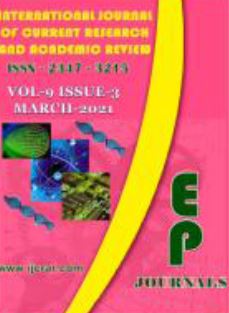Abstract Volume:9 Issue-3 Year-2021 Original Research Articles
 |
Online ISSN : 2347 - 3215 Issues : 12 per year Publisher : Excellent Publishers Email : editorijcret@gmail.com |
Bacteriocins produced by lactic acid bacteria (LAB) are a heterogeneous group of antibacterial proteins that vary in spectrum of activity, mode of action, molecular weight, genetic origin and biochemical properties inhibitory substances include bakery and dairy products, cereals, and bread and cheese. Nisin is a natural bacteriocin produced by Lactococcus lactis. It has a broad inhibitory effect against gram positive bacteria. It can be destroyed be proteolytic enzymes that exist in food systems. We found that, minimum inhibitory concentration of free nisin was higher than encapsulated nisin in both culture media and cheese for L.monocytogenes and S. aureus. E. coli resisted to any form of Nisin in culture media but not in cheese. Nisin A is being used at the concentrations of 100-200 ppm in the preservation of, dairy products such as cheeses and milk. In addition, encapsulation protected nisin against cheese fat and protease. Reuterin is a water – soluble non- proteinaceous product produced by Lactobacillus reuteri. It has been described to have antimicrobial effect against certain gram- negative and gram- positive bacteria, yeasts, fungi, and protozoa. It inhibits Salmonella, Shigella, clostridium, Staphylococcus, Listeria, and Trypanosoma. The aim of present work was to study the combination of Nisin and L. reuteri against eight bacterias (Staphylococcus aureus, Salmonella typhi, Escherchia coli, Klebsiella pneuoniae, Pseudomonas aeruginosa, Bacillus subtilus, Bacillus cereus, Streptococcus spp.) Reuterin was isolated from L. reuteri during the anaerobic fermentation of glycerol using Gas Pack EZ Anaerogas pack container system on MRS agar. Minimum inhibitory concentration of bacterioncins (Nisin, crude Lactobacillus reuteri, Nisin + crude Lactobacillus reuteri) was studied using broth micro dilution method. Bacteriocins reuterin showed best synergism for both gram positive and gram negative bacteria used in the study. MIC of Bacteriocin (Nisin) alone against tested strains was determined to be 0.017+_0.001 to 0.40+_0.002 mg/ml. crude Lactobacillus reuteri alone was determined to be 0.016+_0.001 to 0.033+_0.001mg/ml which is 3 or 2 fold higher for MIC of Bacteriocins(Nisin + crude Lactobacillus reuteri) in combination i.e. 0.010+_0.001to 0.029+_0.001mg/ml. The synergistic activity of Biopreservative i.e. bacteriocins (Nisin and crude Lactobacillus reuteri) with chemical preservative (sorbic acid) for pathogenic bacteria was evaluated using well diffusion assay. The diameter of inhibition zones increased on combination. The highest zone increased was seen in case of Bacteriocins in combination i.e. 29+_0.06 AB-3 (E.coli).
How to cite this article:
Mamta Sahu and Varun Dwivedi. 2021. Studies on Lactobacillus Bacteriocin for Production and Characterization against Some Pathogenic and Food Spoilage Bacteria.Int.J.Curr.Res.Aca.Rev. 9(3): 1-12doi: https://doi.org/10.20546/ijcrar.2021.903.001



Quick Navigation
- Print Article
- Full Text PDF
- How to Cite this Article
- on Google
- on Google Scholor
- Citation Alert By Google Scholar
